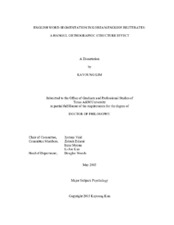| dc.description.abstract | It has been claimed that skilled readers of English syllabify written words using morphological and orthographic knowledge (e.g., the Basic Orthographic Syllable Structure, or BOSS) rather than phonological considerations (e.g., the Maximal Onset Principle, or MOP). However, biliterate English readers whose first language is phonologically transparent have been found to rely on a MOP-based segmentation preference. Little is known about the specific contribution of first language orthographic knowledge on second language word parsing, particularly when the two languages differ in orthographies.
The present research investigated how first learned orthographic knowledge in Korean Hangul may affect word segmentation of a later learned script (English). A split-view lexical decision task was administered in which visually presented stimuli included gaps at junctures corresponding to three different segmentation strategies: a MOP-based strategy, a BOSS-based strategy, and a strategy based on Hangul orthographic structure (HOS). It was hypothesized that lexical decision would be faster and more accurate for stimuli segmented based on a MOP or a HOS analysis than on a BOSS analysis. Of additional interest was whether reliance on a HOS strategy would be greater for readers with greater proficiency in Hangul and for English words that have been borrowed into Korean as loanwords (with a Hangul written counterpart) than for non-borrowed words. Participants in Experiment 1 were native readers of Korean (n = 48) with low English proficiency; Experiment 2 compared Korean-dominant (n = 48) with English-dominant biliterate readers (n = 49). Stimuli in both experiments included 60 borrowed words and 60 non-borrowed words. Results from Experiment 1 found evidence for a Hangul orthography-based segmentation strategy, particularly for loanwords. Experiment 2 found a HOS effect among Korean-dominant readers for loanwords and a weaker HOS effect for non-borrowed words. By contrast, English-dominant readers did not show a differential HOS preference as a function of loanword status. Furthermore, across experiments, all groups demonstrated a MOP effect in response time and accuracy. Taken together, the findings are discussed in terms of transfer effects of L1 alphasyllabic Hangul writing system characteristics to the reading of words in an L2 alphabetic writing system. | en |


